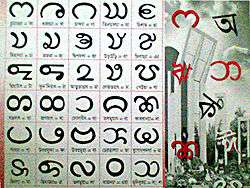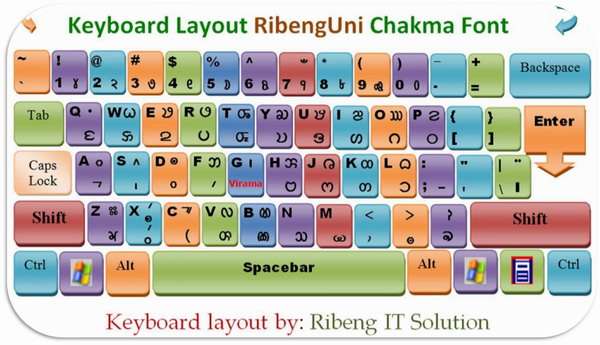Chakma alphabet
| Chakma | |
|---|---|
 | |
| Type | |
| Languages | Chakma language |
Parent systems | |
| Direction | Left-to-right |
| ISO 15924 |
Cakm, 349 |
Unicode alias | Chakma |
| U+11100–U+1114F | |
The Chakma alphabet (Ajhā pāṭh), also called Ojhapath, Ojhopath, Aaojhapath, is an abugida used for the Chakma language and which is being adapted for the Tanchangya language.[1] The forms of the letters are quite similar to those of the Burmese script.
Origin
The Chakma alphabet is probably descended from Brahmi through Pallavi. Proto Chakma developed around the 6th century CE. Old Chakma developed in the 8th century CE. Classical Literary Chakma was used in the 11th to 15th centuries and the current Standard Chakma was developed and revived in the 20th century.
Classical Chakma was probably a sister script of Tai Tham and Tai Lue scripts of Northern Thailand also from the 8th century CE.
Structure
Chakma is of the Brahmic type: the consonant letters contain an inherent vowel. Unusually for Brahmic scripts, the inherent vowel in Chakma is a long 'ā' (aː) as opposed to short 'a' (ə) which is standard in most other languages of India such as Hindi, Marathi or Tamil. Consonant clusters are written with conjunct characters, and a visible vowel killer shows the deletion of the inherent vowel when there is no conjunct.
Vowels
Four independent vowels exist: 𑄃 a, 𑄄 i, 𑄅 u, and 𑄆 e. Other vowels in initial position are formed by adding the vowel sign to 𑄃 a, as in 𑄃𑄩 ī, 𑄃𑄫 ū, 𑄃𑄭 ai, 𑄃𑄰 oi. Some modern writers are generalizing this spelling in 𑄃𑄨 i, 𑄃𑄪 u, and 𑄬𑄃 e.
Chakma vowel signs with the letter 𑄇 ka are given below:
𑄇 Ka = 𑄇 Ka
𑄇𑄧 Ka = 𑄇 Kā + 𑄧 - a (11127)
𑄇𑄨 Ki = 𑄇 Kā + 𑄨 - i (11128)
𑄇𑄩 Kī = 𑄇 Kā + 𑄩 - ī (11129)
𑄇𑄪 Ku = 𑄇 Kā + 𑄪 - u (1112A)
𑄇𑄫 Kū = 𑄇 Kā + 𑄫 - ū (1112B)
𑄬𑄇 Ke = 𑄇 Kā + 𑄬 - e (1112C)
𑄇𑄭 Kāi = 𑄇 Kā + 𑄭 - āi (1112D)
𑄇𑄮 Ko = 𑄇 Kā + 𑄮 - o (1112E)
𑄇𑄯 Kau = 𑄇 Kā + 𑄯 - au (1112F)
𑄇𑄰 Koi = 𑄇 Kā + 𑄰 - oi (11130)
𑄇𑄀 Kaṃ = 𑄇 Kā + 𑄀 - ṃ (11100)
𑄇𑄁 Kaṃ = 𑄇 Kā + 𑄁 - ṃ (11101)
𑄇𑄂 Kaḥ = 𑄇 Kā + 𑄂 - ḥ (11102)
𑄇𑄴 K = 𑄇 Kā + 𑄴 - MAAYYAA (11134)
One of the interesting features of Chakma writing is that candrabindu (cānaphudā) can be used together with anusvara (ekaphudā) and visarga (dviphudā):
𑄃𑄳𑄂𑄀 Aḥṃ = 𑄃 ā + 𑄂 h + 𑄀ṃ
𑄃𑄳𑄁𑄀 Aṃṃ = 𑄃 ā + 𑄁 ṃ + 𑄀ṃ
𑄅𑄳𑄁𑄀 Uṃṃ = 𑄅 u + 𑄁 ṃ + 𑄀ṃ
𑄟𑄀𑄪 Muṃ = 𑄟 mā + 𑄪 u + 𑄀ṃ
Consonants with killed Vowels and Conjunct Consonants
Like other Brahmic scripts, Chakma makes use of the maayyaa (killer) to invoke conjoined consonants. In the past, practice was much more common than it is today. Like the Myanmar script, Chakma is encoded with two vowel-killing characters in order to conform to modern user expectations. As shown above, most letters have their vowels killed with the use of the explicit maayyaa:
𑄇𑄴 k = 𑄇 kā + 𑄴 MAAYYAA
In 2001 an orthographic reform was recommended in the book Cāṅmā pattham pāt which would limit the standard repertoire of conjuncts to those composed with the five letters 𑄠 yā, 𑄢 rā, 𑄣 lā, 𑄤 wā, and 𑄚 nā. The four here are the most widely accepted repertoire of conjuncts.
ya: X + 𑄳 VIRAMA + 𑄠 yā
𑄇𑄳𑄡 𑄈𑄳𑄡 𑄉𑄳𑄡 𑄊𑄳𑄡 𑄋𑄳𑄡 - 𑄌𑄳𑄡 𑄍𑄳𑄡 𑄎𑄳𑄡 𑄏𑄳𑄡 𑄐𑄳𑄡 - 𑄑𑄳𑄡 𑄒𑄳𑄡 𑄓𑄳𑄡 𑄔𑄳𑄡 𑄕𑄳𑄡
𑄖𑄳𑄡 𑄗𑄳𑄡 𑄘𑄳𑄡 𑄙𑄳𑄡 𑄚𑄳𑄡 - 𑄛𑄳𑄡 𑄜𑄳𑄡 𑄝𑄳𑄡 𑄞𑄳𑄡 𑄟𑄳𑄡 - 𑄦𑄳𑄡 𑄠𑄳𑄡 𑄡𑄳𑄡 𑄢𑄳𑄡 𑄤𑄳𑄡 𑄥𑄳𑄡
ra: X + 𑄳 VIRAMA + 𑄢 rā
𑄇𑄳𑄢 𑄈𑄳𑄢 𑄉𑄳𑄢 𑄊𑄳𑄢 𑄋𑄳𑄢 - 𑄌𑄳𑄢 𑄍𑄳𑄢 𑄎𑄳𑄢 𑄏𑄳𑄢 𑄐𑄳𑄢 - 𑄑𑄳𑄢 𑄒𑄳𑄢 𑄓𑄳𑄢 𑄔𑄳𑄢 𑄕𑄳𑄢
𑄖𑄳𑄢 𑄗𑄳𑄢 𑄘𑄳𑄢 𑄙𑄳𑄢 𑄚𑄳𑄢 - 𑄛𑄳𑄢 𑄜𑄳𑄢 𑄝𑄳𑄢 𑄞𑄳𑄢 𑄟𑄳𑄢 - 𑄦𑄳𑄢 𑄠𑄳𑄢 𑄡𑄳𑄢 𑄢𑄳𑄡 𑄤𑄳𑄢 𑄥𑄳𑄢
la: X + 𑄳 VIRAMA + 𑄣 lā
𑄇𑄳𑄣 𑄈𑄳𑄣 𑄉𑄳𑄣 𑄊𑄳𑄣 𑄋𑄳𑄣 - 𑄌𑄳𑄣 𑄍𑄳𑄣 𑄎𑄳𑄣 𑄏𑄳𑄣 𑄐𑄳𑄣 - 𑄑𑄳𑄣 𑄒𑄳𑄣 𑄓𑄳𑄣 𑄔𑄳𑄣 𑄕𑄳𑄣
𑄖𑄳𑄣 𑄗𑄳𑄣 𑄘𑄳𑄣 𑄙𑄳𑄣 𑄚𑄳𑄣 - 𑄛𑄳𑄣 𑄜𑄳𑄣 𑄝𑄳𑄣 𑄞𑄳𑄣 𑄟𑄳𑄣 - 𑄦𑄳𑄣 𑄠𑄳𑄣 𑄡𑄳𑄣 𑄢𑄳𑄣 𑄥𑄳𑄣
wa: X + 𑄳 VIRAMA + 𑄤 wā
𑄇𑄳𑄤 𑄈𑄳𑄤 𑄉𑄳𑄤 𑄊𑄳𑄤 𑄋𑄳𑄤 - 𑄌𑄳𑄤 𑄍𑄳𑄤 𑄎𑄳𑄤 𑄏𑄳𑄤 𑄐𑄳𑄤 - 𑄑𑄳𑄤 𑄒𑄳𑄤 𑄓𑄳𑄤 𑄔𑄳𑄤 𑄕𑄳𑄤
𑄖𑄳𑄤 𑄗𑄳𑄤 𑄘𑄳𑄤 𑄙𑄳𑄤 𑄚𑄳𑄤 - 𑄛𑄳𑄤 𑄜𑄳𑄤 𑄝𑄳𑄤 𑄞𑄳𑄤 𑄟𑄳𑄤 - 𑄦𑄳𑄤 𑄠𑄳𑄤 𑄡𑄳𑄤 𑄢𑄳𑄤 𑄥𑄳𑄤
No separate conjunct forms of subjoined full-form -yā or -rā appear to exist. The fifth of these conjuncts, the -na conjunct, is exemplary of the orthographic shift which has taken place in the Chakma language.
na: X + 𑄳 VIRAMA + 𑄚 nā
𑄇𑄳𑄚 𑄈𑄳𑄚 𑄉𑄳𑄚 𑄊𑄳𑄚 𑄋𑄳𑄚 - 𑄌𑄳𑄚 𑄍𑄳𑄚 𑄎𑄳𑄚 𑄏𑄳𑄚 𑄐𑄳𑄚 - 𑄑𑄳𑄚 𑄒𑄳𑄚 𑄓𑄳𑄚 𑄔𑄳𑄚 𑄕𑄳𑄚
𑄖𑄳𑄚 𑄗𑄳𑄚 𑄘𑄳𑄚 𑄙𑄳𑄚 𑄚𑄳𑄚 - 𑄛𑄳𑄚 𑄜𑄳𑄚 𑄝𑄳𑄚 𑄞𑄳𑄚 𑄟𑄳𑄚 - 𑄦𑄳𑄚 𑄠𑄳𑄚 𑄡𑄳𑄚 𑄢𑄳𑄚 𑄥𑄳𑄚
While some writers would indeed write kakna (in ligating style) as 𑄇𑄇𑄳𑄚 or (in subjoining style) as 𑄇𑄇𑄳𑄚, most now would probably expect it to be written as 𑄇𑄇𑄴𑄚. The ligating style of glyphs is now considered old-fashioned. Thus, taking the letter 𑄟 mā as the second element, while the glyph shapes 𑄇𑄳𑄟 kmā, 𑄖𑄳𑄟 tmā, 𑄚𑄳𑄟 nmā, 𑄝𑄳𑄝 bbā, 𑄟𑄳𑄟 mmā, 𑄣𑄳𑄣 llā, 𑄥𑄳𑄟 smā, and 𑄦𑄳𑄟 hmā are attested, most users now prefer the glyph shapes 𑄇𑄳𑄟 kmā, 𑄖𑄳𑄟 tmā, 𑄚𑄳𑄟 nmā, 𑄝𑄳𑄝 bbā, 𑄟𑄳𑄟 mmā, 𑄣𑄳𑄣 llā, 𑄥𑄳𑄟 smā, and 𑄦𑄳𑄟 hmā. Again, this distinction is stylistic and not orthographic.
The 2004 book Phadagaṅ shows examples of the five conjuncts above together alongside conjuncts formed with 𑄝 bā, 𑄟 mā, and 𑄦 hā. These are all formed by simple subjoining.
ba: X + 𑄳 VIRAMA + 𑄝 nā
𑄇𑄳𑄝 𑄈𑄳𑄝 𑄉𑄳𑄝 𑄊𑄳𑄝 𑄋𑄳𑄝 - 𑄌𑄳𑄝 𑄍𑄳𑄝 𑄎𑄳𑄝 𑄏𑄳𑄝 𑄐𑄳𑄌 - 𑄑𑄳𑄝 𑄒𑄳𑄝 𑄓𑄳𑄝 𑄔𑄳𑄚 𑄕𑄳𑄝
𑄖𑄳𑄝 𑄗𑄳𑄝 𑄘𑄳𑄝 𑄙𑄳𑄝 𑄚𑄳𑄚 - 𑄛𑄳𑄝 𑄜𑄳𑄝 𑄝𑄳𑄝 𑄞𑄳𑄝 𑄟𑄳𑄝 - 𑄠𑄳𑄝 𑄡𑄳𑄝 𑄢𑄳𑄝 𑄣𑄳𑄝 𑄤𑄳𑄝 𑄥𑄳𑄝
ma: X + 𑄳 VIRAMA + 𑄟 nā
𑄇𑄳𑄟 𑄈𑄳𑄟 𑄉𑄳𑄟 𑄊𑄳𑄟 𑄋𑄳𑄟 - 𑄌𑄳𑄟 𑄍𑄳𑄟 𑄎𑄳𑄟 𑄏𑄳𑄟 𑄐𑄳𑄟 - 𑄑𑄳𑄟 𑄒𑄳𑄟 𑄓𑄳𑄟 𑄔𑄳𑄟 𑄕𑄳𑄟
𑄖𑄳𑄟 𑄗𑄳𑄟 𑄘𑄳𑄟 𑄙𑄳𑄟 𑄚𑄳𑄟 - 𑄛𑄳𑄟 𑄜𑄳𑄟 𑄝𑄳𑄟 𑄞𑄳𑄟 𑄟𑄳𑄟 - 𑄠𑄳𑄟 𑄡𑄳𑄟 𑄢𑄳𑄟 𑄣𑄳𑄟 𑄤𑄳𑄟 𑄥𑄳𑄟
ha: X + 𑄳 VIRAMA + 𑄦 nā
𑄇𑄳𑄦 𑄈𑄳𑄦 𑄉𑄳𑄦 𑄊𑄳𑄦 𑄋𑄳𑄦 - 𑄌𑄳𑄦 𑄍𑄳𑄦 𑄎𑄳𑄦 𑄏𑄳𑄦 𑄐𑄳𑄦 - 𑄑𑄳𑄦 𑄒𑄳𑄦 𑄓𑄳𑄦 𑄔𑄳𑄦 𑄕𑄳𑄦
𑄖𑄳𑄦 𑄗𑄳𑄦 𑄘𑄳𑄦 𑄙𑄳𑄦 𑄚𑄳𑄦 - 𑄛𑄳𑄦 𑄜𑄳𑄦 𑄝𑄳𑄦 𑄞𑄳𑄦 𑄟𑄳𑄦 - 𑄠𑄳𑄦 𑄡𑄳𑄦 𑄢𑄳𑄦 𑄣𑄳𑄦 𑄤𑄳𑄦 𑄥𑄳𑄦
In the 1982 book Cāṅmār āg pudhi a much wider range of conjunct pairs is shown, some of them with fairly complicated glyphs:
𑄇𑄳𑄇 Kkā = 𑄇 Kā + 𑄳 VIRAMA + 𑄇 Kā
𑄇𑄳𑄑 Ktā = 𑄇 Kā + 𑄳 VIRAMA + 𑄑 Tā
𑄇𑄳𑄖 Ktā = 𑄇 Kā + 𑄳 VIRAMA + 𑄖 Tā
𑄇𑄳𑄟 Kmā = 𑄇 Kā + 𑄳 VIRAMA + 𑄟 Mā
𑄇𑄳𑄌 Kcā = 𑄇 Kā + 𑄳 VIRAMA + 𑄌 Cā
𑄋𑄳𑄇 ńkā = 𑄋 ńā + 𑄳 VIRAMA + 𑄇 Kā
𑄋𑄳𑄉 ńkā = 𑄋 ńā + 𑄳 VIRAMA + 𑄉 Gā
𑄌𑄳𑄌 ccā = 𑄌 cā + 𑄳 VIRAMA + 𑄌 Cā
𑄌𑄳𑄍 Cchā = 𑄌 Cā + 𑄳 VIRAMA + 𑄍 Chā
𑄐𑄳𑄌 ñcā = 𑄐 ñā + 𑄳 VIRAMA + 𑄌 Cā
𑄐𑄳𑄎 ñjā = 𑄐 ñā + 𑄳 VIRAMA + 𑄎 Jā
𑄐𑄳𑄏 Ñjhā = 𑄐 ñā + 𑄳 VIRAMA + 𑄏 Jhā
𑄑𑄳𑄑 Ttā = 𑄑 Tā + 𑄳 VIRAMA + 𑄑 Tā
𑄖𑄳𑄖 Ttā = 𑄖 Tā + 𑄳 VIRAMA + 𑄖 Tā
𑄖𑄳𑄟 Tmā = 𑄖 Tā + 𑄳 VIRAMA + 𑄟 mā
𑄖𑄳𑄗 Tthā = 𑄖 Tā + 𑄳 VIRAMA + 𑄗 Thā
𑄘𑄳𑄘 Ddā = 𑄘 Dā + 𑄳 VIRAMA + 𑄘 Dā
𑄘𑄳𑄙 Ddhā = 𑄘 Dā + 𑄳 VIRAMA + 𑄙 Dhā
𑄚𑄳𑄖 ntā = 𑄚 nā + 𑄳 VIRAMA + 𑄖 tā
𑄚𑄳𑄗 nthā = 𑄚 nā + 𑄳 VIRAMA + 𑄗 thā
𑄚𑄳𑄟 nmā = 𑄚 nā + 𑄳 VIRAMA + 𑄟 mā
𑄛𑄳𑄛 ppā = 𑄛 pā + 𑄳 VIRAMA + 𑄛 pā
𑄝𑄳𑄝 bbā = 𑄝 bā + 𑄳 VIRAMA + 𑄝 bā
𑄟𑄳𑄟 mmā = 𑄟 mā + 𑄳 VIRAMA + 𑄟 mā
𑄎𑄳𑄎 jjā = 𑄎 jā + 𑄳 VIRAMA + 𑄎 jā
𑄣𑄳𑄇 lkā = 𑄣 lā + 𑄳 VIRAMA + 𑄇 kā
𑄣𑄳𑄉 lgā = 𑄣 lā + 𑄳 VIRAMA + 𑄉 gā
𑄣𑄳𑄣 llā = 𑄣 lā + 𑄳 VIRAMA + 𑄣 lā
𑄣𑄳𑄑 ltā = 𑄣 lā + 𑄳 VIRAMA + 𑄑 tā
𑄣𑄳𑄛 lpā = 𑄣 lā + 𑄳 VIRAMA + 𑄛 pā
𑄣𑄳𑄍 lchā = 𑄣 lā + 𑄳 VIRAMA + 𑄍 chā
𑄥𑄳𑄑 stā = 𑄥 sā + 𑄳 VIRAMA + 𑄑 tā
𑄥𑄳𑄇 skā = 𑄥 sā + 𑄳 VIRAMA + 𑄇 kā
𑄥𑄳𑄛 spā = 𑄥 sā + 𑄳 VIRAMA + 𑄛 pā
𑄥𑄳𑄟 smā = 𑄥 sā + 𑄳 VIRAMA + 𑄟 mā
𑄦𑄳𑄟 hmā = 𑄦 hā + 𑄳 VIRAMA + 𑄟 hmā
Letter, punctuation and digit names
Chakma letters have a descriptive name followed by a traditional Brahmic consonant. These are given in annotations to the character names. Alongside a single and double danda punctuation, Chakma has a unique question mark, and a section sign, Phulacihna. There is some variation in the glyphs for the Phulacihna,some looking like flowers or leaves. A set of digits exists although Bengali digits are also used.
Keyboard layout

Unicode
Chakma script was added to the Unicode Standard in January, 2012 with the release of version 6.1.
The Unicode block for Chakma script is U+11100–U+1114F. Grey areas indicate non-assigned code points:
| Chakma[1][2] Official Unicode Consortium code chart (PDF) | ||||||||||||||||
| 0 | 1 | 2 | 3 | 4 | 5 | 6 | 7 | 8 | 9 | A | B | C | D | E | F | |
| U+1110x | 𑄀 | 𑄁 | 𑄂 | 𑄃 | 𑄄 | 𑄅 | 𑄆 | 𑄇 | 𑄈 | 𑄉 | 𑄊 | 𑄋 | 𑄌 | 𑄍 | 𑄎 | 𑄏 |
| U+1111x | 𑄐 | 𑄑 | 𑄒 | 𑄓 | 𑄔 | 𑄕 | 𑄖 | 𑄗 | 𑄘 | 𑄙 | 𑄚 | 𑄛 | 𑄜 | 𑄝 | 𑄞 | 𑄟 |
| U+1112x | 𑄠 | 𑄡 | 𑄢 | 𑄣 | 𑄤 | 𑄥 | 𑄦 | 𑄧 | 𑄨 | 𑄩 | 𑄪 | 𑄫 | 𑄬 | 𑄭 | 𑄮 | 𑄯 |
| U+1113x | 𑄰 | 𑄱 | 𑄲 | 𑄳 | 𑄴 | 𑄶 | 𑄷 | 𑄸 | 𑄹 | 𑄺 | 𑄻 | 𑄼 | 𑄽 | 𑄾 | 𑄿 | |
| U+1114x | 𑅀 | 𑅁 | 𑅂 | 𑅃 | ||||||||||||
| Notes | ||||||||||||||||
References
- ↑ RibengUni="http://uni.hilledu.com "
External links
- RibengUni (First & Only Chakma Unicode Font)
- Chakma Script
- Chakma Bangla Blog
- Chakma Keyboard Layout for Mac OSX*Chakma Open Dictionary
- "Chakma alphabet, pronunciation and language". Omniglot. Retrieved 2012-09-02.
- "About UNICODE Chakma Font (Script) supported in your any OS". Retrieved 2012-09-02.
- "Tribal Languages - Bangladesh Wiki (বাংলাদেশ)". Retrieved 2012-09-02.
- "Honour for writers". The Telegraph - Calcutta (Kolkata). 2009-01-07. Retrieved 2012-09-02.
Bibliography
- Cāṅmā, Cirajyoti and Maṅgal Cāṅgmā. 1982. Cāṅmār āg pudhi (Chakma primer). Rāṅamāṭi:Cāṅmābhāṣā Prakāśanā Pariṣad.
- Khisa, Bhagadatta. 2001. Cāṅmā pattham pāt (Chakma primer.) Rāṅamāṭi: Tribal Cultural Institute(TCI).
- Singā. 2004. Phagadāṅ